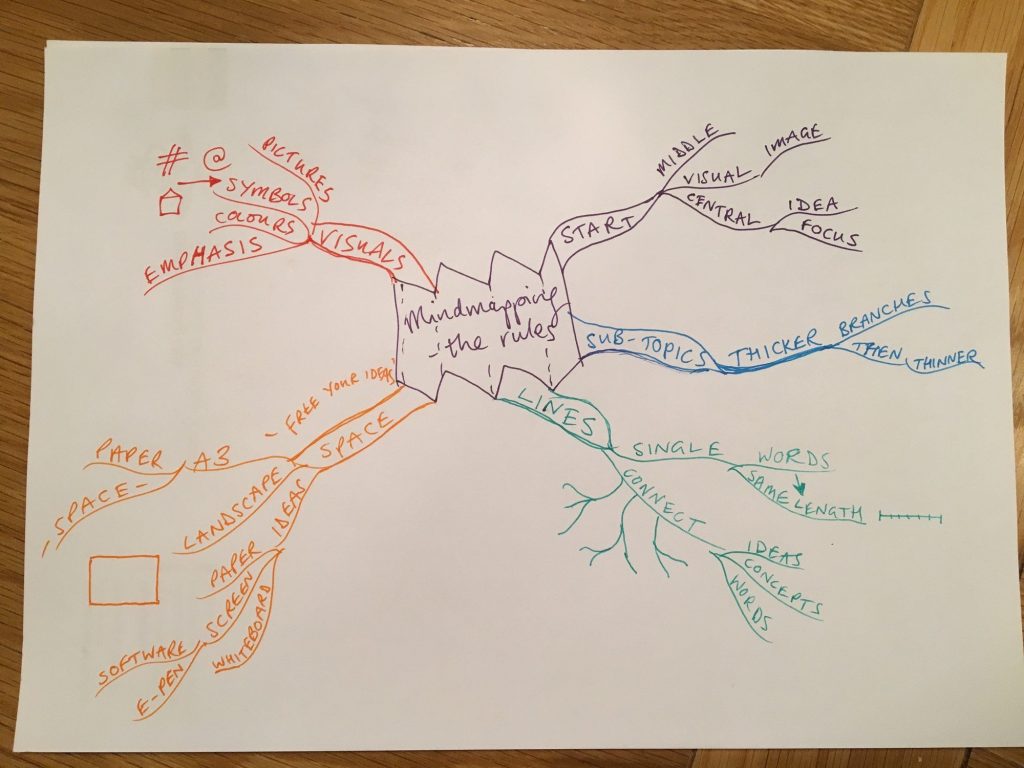Mind mapping was made popular by Tony Buzan in the 1970’s, but you can argue that versions of it have been around forever. Cave paintings, hieroglyphics, illustrated manuscripts, and more recently spider diagrams, Ishikawa diagrams and visual storytelling draw on similar principles to capture and communicate information.
If you’ve ever wondered how to make these tree-like structures yourself, here’s a quick introduction to some key concepts, and some practical advice for getting started.
Focus on process, not outcome
A lot of the visual examples above focus on the output of the thinking process. Mind mapping, on the other hand, emphasises the process itself: the analysis, thinking and editing that happens as you create one.
I’ve used mind maps for study and professional work for over two decades; they’ve helped me scan and summarise books, revise for exams, prepare for interviews, analyse research data and capture conference notes, to name just a few.
Mind maps in the real world
You can use maps for all kinds of things, from planning a house move to summarising themes across the entire works of Shakespeare, if that’s your thing! Here are some ways they can help:
Planning and organisation
Mind maps challenge you to prioritise and sort via the central branches, so they can be great for planning and organising. This could include:
- Daily or weekly activity planning
- Workshops and lesson plans
- Projects and strategic planning
Learning and memory
Mind maps incorporate techniques associated with learning and remembering, including key words, connecting concepts, underlining, use of colour, and visuals. This means they’re handy for things like:
- Note-taking for lectures, seminars and presentations
- Summarising articles, journals and books
- Revision for assignments and exams
Creativity and innovation
Mind maps can supercharge creative thinking, and are great for shifting writer’s block and generating ideas. I’ve used maps for things like:
- Brainstorming creative projects
- Design thinking and planning cycles
- Organising ideas for writing articles, reports and presentations
Basic mind mapping guidelines
The original ‘rules’ of mind mapping are fairly simple, as you can see from the hand-drawn map below:

- Start in the middle, with your central idea or topic. Add a simple visual as the central image;
- Use central branches (thicker) to focus on key concepts; add sub-topic branches (thinner) as you add detail;
- Write on lines, using single words if you can;
- Work in landscape, making use of space to expand ideas;
- Use visual emphasis like colours, symbols and images.
Here’s an example of a more complex mind map. This maps some key points from an article in The Economist (‘Uncanny University‘, August 2020). Can you see some of the ‘rules’ of mind mapping?

My map above also breaks some of the classic conventions of mind mapping: multiple words per line; writing underneath some lines (not on them); little use of colour for emphasis.
The process was what counted for me, though – constructing the map helped me digest a long article so I could share back key points with others.
…but I can’t draw!
It’s funny – mind maps have a way of making it look like you can draw, even though you’ve just added a child-like house and a few stick people. Here are a few FAQs I often hear about mind mapping:
- Do I need to be able to draw?
No – you can use symbols, stick people, lines, arrows and connectors to help communicate core ideas. Have a look at the emojis in your phone – they’re a great way to see how simple visuals can be! - Do I need to be creative?
No – but the nature of mind maps can really help push your creative boundaries. Add empty branches to your map and ask your brain to fill them; or start a new map from one of your central branches - How can I listen and make a mind map at the same time? I can’t multitask!
Agreed – this is hard, and even more so if the speaker is not well structured or clear. If you really want to focus, however, mapping whilst you listen is a fantastic brain workout!
If you’d like to see an example of how a map can come together, here’s a speedy version of one I created to summarise the results of a faculty survey last year:
Feeling inspired?
The best way to get into mind mapping is, well, to get into it! Start with a simple topic that you know well, and see what happens. Then do it again the next day, and the next…
I’ve also seen mind mapping make its way into learning support toolkits at many universities around the world. A quick search found these examples from a few universities in Australia:
If you’d like to get hands-on with mind mapping and learn some practical basics, register and come along for ‘Make your own mind maps, an in-person Tooltime event. Take a break from the screen and enjoy some pen-and-paper time!
